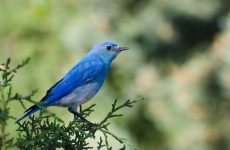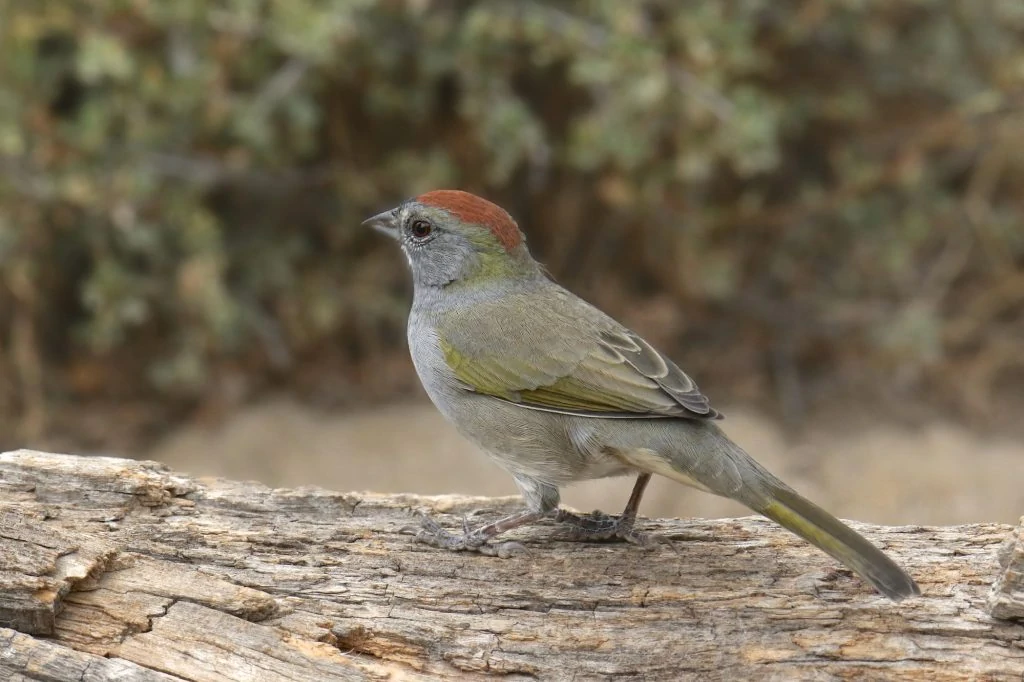
Towhees are long-tailed and larger members of the sparrow family. They are split into two groups – the Rufous-sided Towhees, which are named after the reddish-brown coloring on their bodies, and Brown Towhees, which are naturally brown all over.
Towhees are generally shy birds that prefer to stay close to the shade under the protective cover of shrubs and thickets. They are often heard before they are seen noisily jumping and double-scratching with both feet under fallen leaves, looking for insects, seeds, and berries.
Although Towhees prefer to be alone, a group of Towhees is called a ‘tangle’ or a ‘teapot.’ These names come from their love of dark tangled undergrowth and their ‘drink-your-tea’ sounding song.
Towhees do visit backyards and parks in search of food and water.
There are 13 species of Towhee in the world, and of these, six live in North America.
This guide will help you identify the types of Towhees spotted in North America according to avibase. The birds in this list are ordered by how frequently they are spotted, from most frequent to least frequent, according to bird watchers’ checklists for the state submitted to ebird.
1. Eastern Towhee
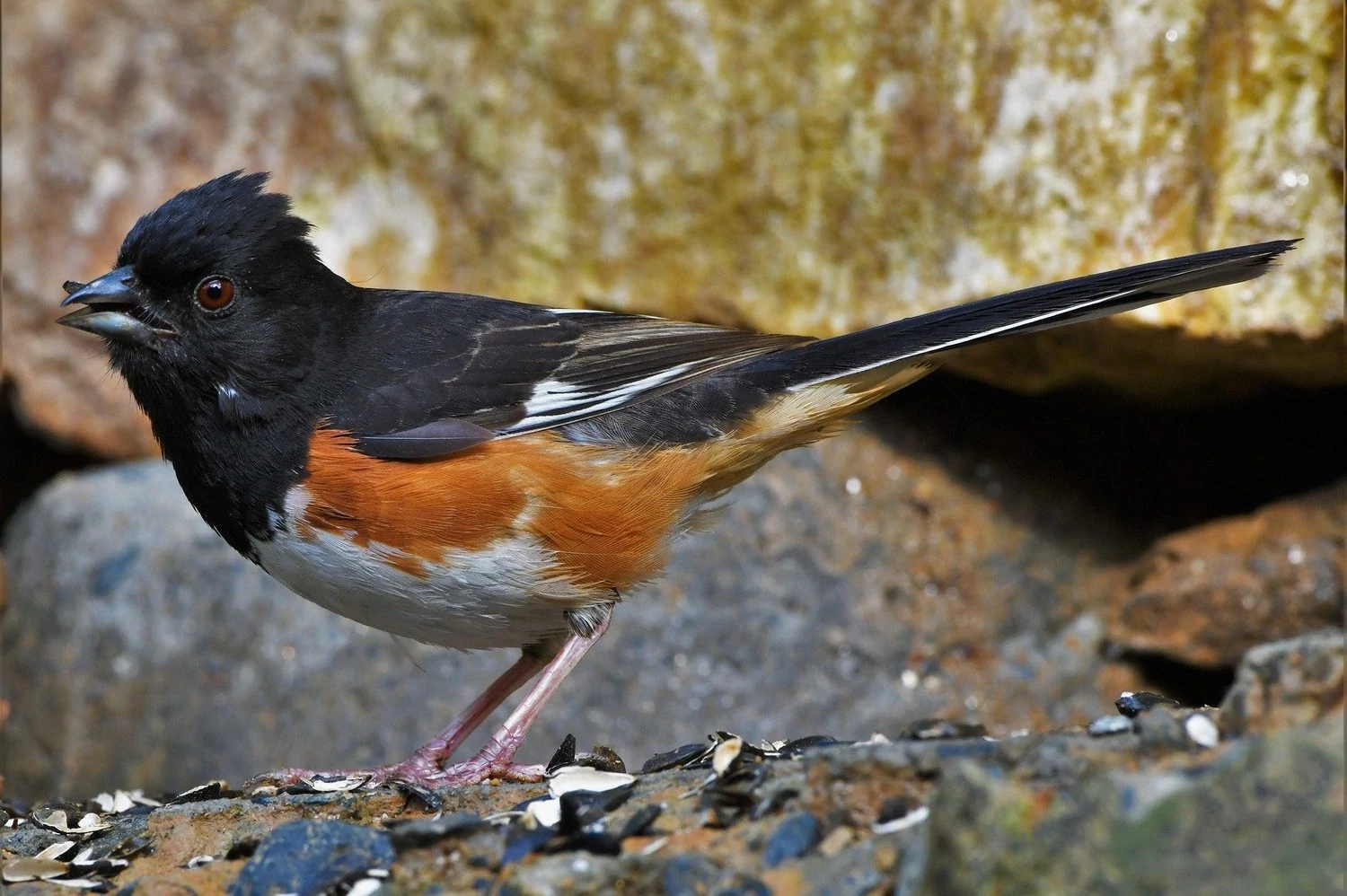
Eastern Towhees are striking large sparrows, about the size of Robin, with a black head, throat, and back, reddish sides, long tails, and a white belly in the males. Females are similar but brown instead of black.
- Pipilo erythrophthalmus
- Length: 6.8-8.2 in (17.3-20.8 cm)
- Weight: 1.1-1.8 oz (32-52 g)
- Wingspan: 7.9-11.0 in (20-28 cm)
Eastern Towhees live all year in the southeastern US States, but birds further north move south for the winter.
You can find Eastern Towhees rummaging in the undergrowth and along the edges of forests and thickets.
Eastern Towhee sounds: Their song is a sharp note, followed by a trill.
Nests of Eastern Towhees are usually on the ground, hidden in fallen leaves. They are made from twigs, bark, and leaves, lined with soft grass and animal hair. They lay up to six eggs, which take just under two weeks to hatch and the same for young to fledge.
Attract Eastern Towhees to your backyard with overgrown borders and platform feeders with black oil sunflower seeds, hulled sunflower seeds, cracked corn, and millet.
Fun fact: Eastern Towhees love the sun and will be found on south-facing slopes
2. Spotted Towhee
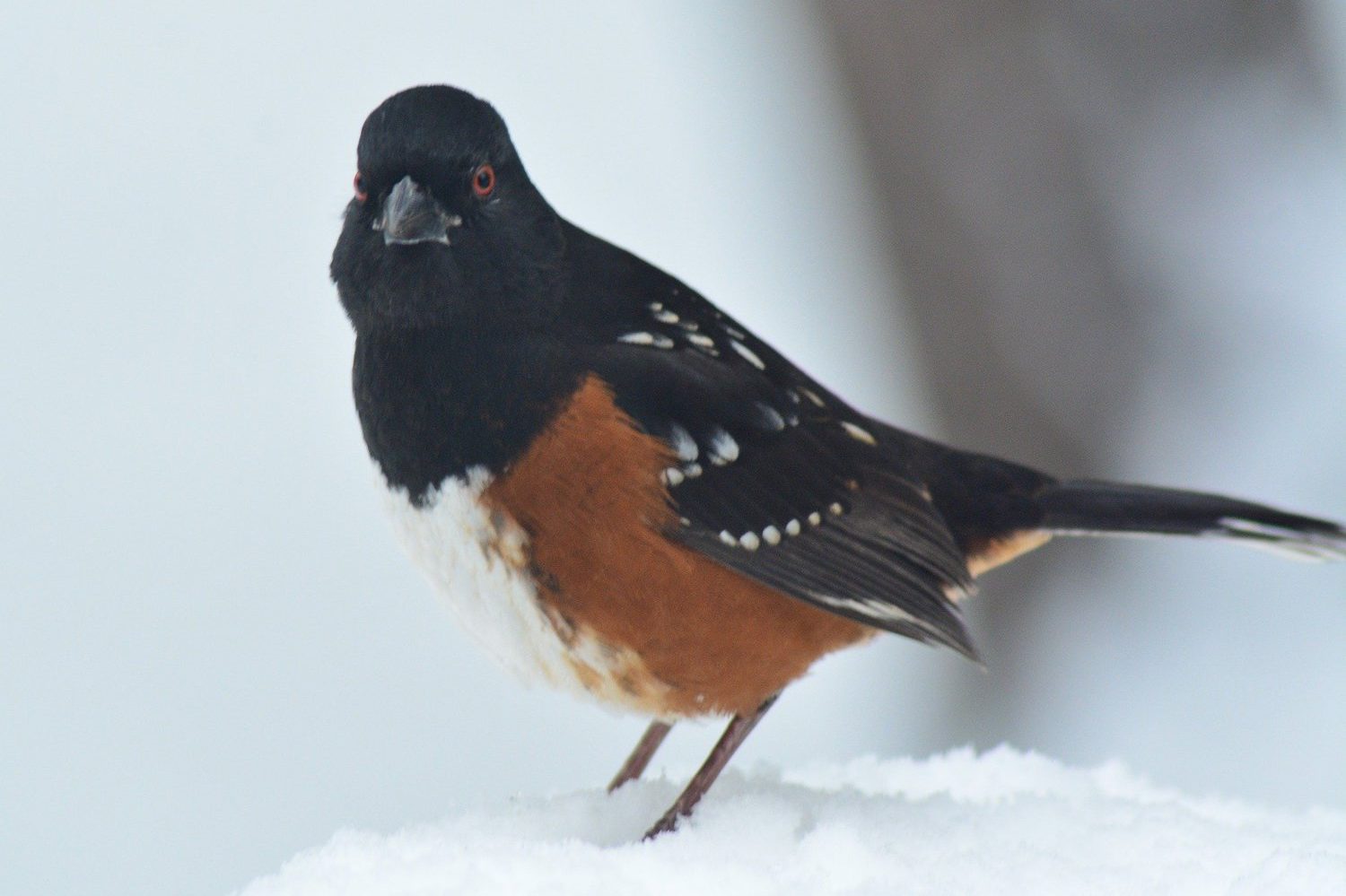
Spotted Towhees are large sparrows that are black on the head, throat, and back in the males and brown in the females. Both males and females have reddish-brown sides and white bellies, with white spots on their wings and back and long tails.
- Pipilo maculatus
- Length: 6.7-8.3 in (17-21 cm)
- Weight: 1.2-1.7 oz (33-49 g)
- Wingspan: 11.0 in (28 cm)
Spotted Towhees live in western US states, but those inland in the north migrate south to Texas after breeding down.
Spotted Towhees can be found on the ground in dense tangles of shrubs scratching around for insects, including beetles, crickets, grasshoppers, caterpillars, wasps, and bees. They also eat acorns, berries, and seeds.
Spotted Towhee sounds: Songs are short notes followed by fast trills.
Nests of Spotted Towhees are usually on or near the ground and made from leaves, stems, and bark lined with softer material. They lay up to six eggs, which take around two weeks to hatch and a further ten days for the young to fledge.
Attract Spotted Towhees to your yard if you leave overgrown borders, and they will visit platform feeders or ground feeders for Black Oil Sunflower seeds, Hulled Sunflower seeds, Cracked Corn, Millet, and Milo.
Fun fact: Spotted Towhee males spend most of their mornings singing when trying to attract a mate.
3. California Towhee
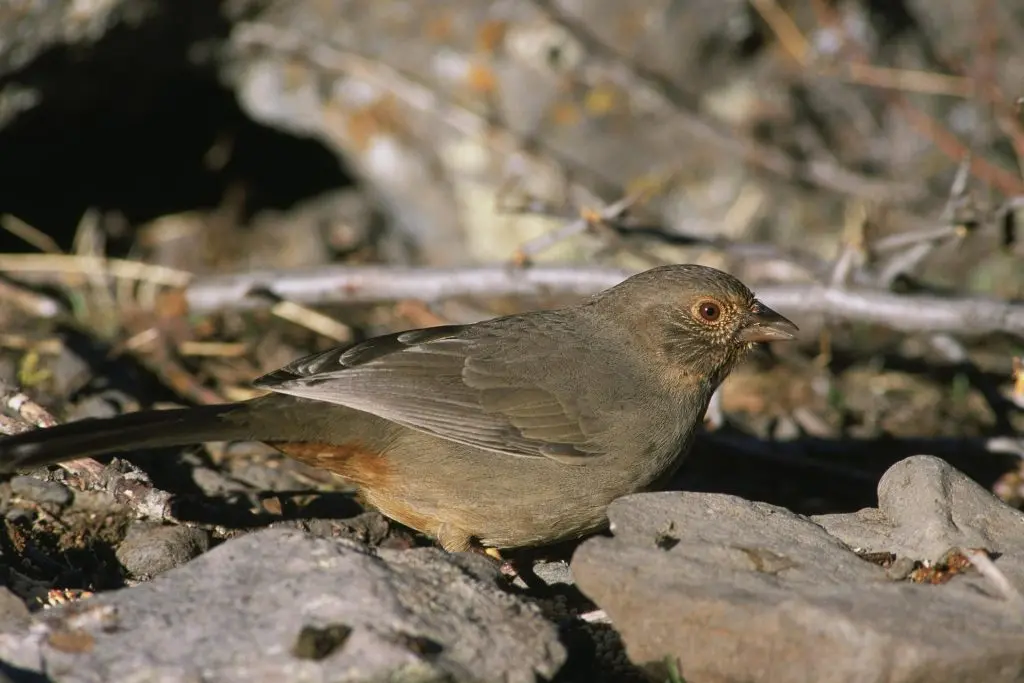
California Towhees are large, brown, plump sparrows with long tails, short wings, and a rusty patch under their tails.
- Melozone crissalis
- Length: 8.3-9.8 in (21-25 cm)
- Weight: 1.3-2.4 oz (37-67 g)
- Wingspan: 11.4 in (29 cm)
California Towhees are only found in the coastal chaparral scrub areas of California, Oregon, and Baja California. They will also visit backyards, sit on fenceposts, and chase their reflections in car mirrors or windows.
California Towhees’ diet is mostly seeds from grasses and herbs, but they also eat berries such as elderberry, coffeeberry, and acorns.
California Towhee sounds: The males sing a simple song that consists of a short, fast trill at a couple of different pitches.
Nests of California Towhees are pretty low down in shrubs or small trees and are made from twigs and grass woven together. The inside of the nest is lined with softer material, such as animal hair and soft fluffy seeds.
They lay up to five eggs, and these take up to two weeks to hatch and at least a week for the young to fledge.
Attract Califonia Towhees to your yard with millet on-ground feeders and plant native berry plants.
Fun fact: California Towhees will attack their reflections in mirrors and windows.
4. Abert’s Towhee
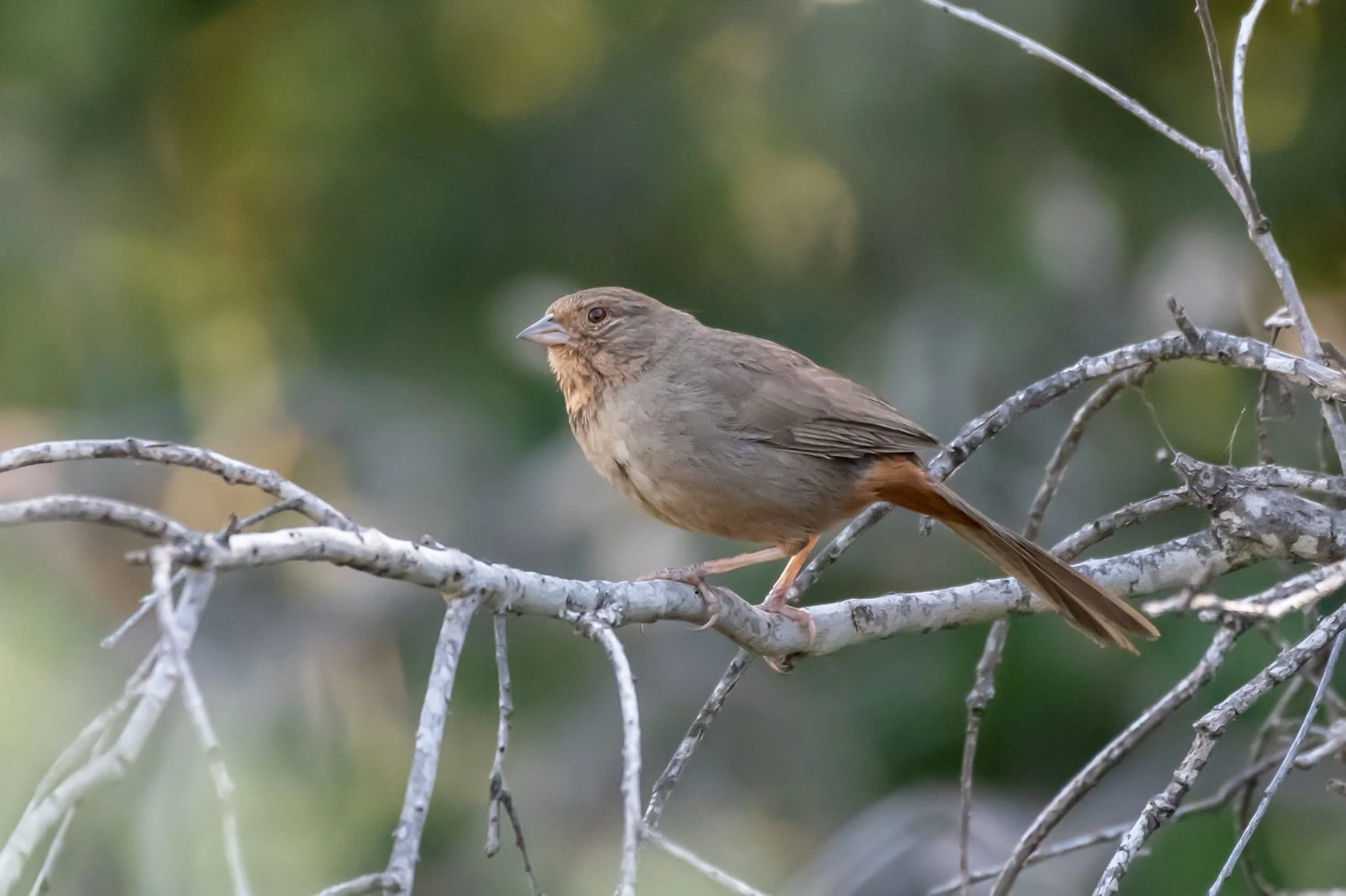
Abert’s Towhees are large grayish-brown sparrows, about the size of a robin, with rusty colors under their tail.
- Melozone aberti
- Length: 8.3-9.1 in (21.2-23.1 cm)
- Weight: 1.5-1.9 oz (42.5-54.9 g)
- Wingspan: 10.4-11.6 in (26.5-29.5 cm)
They are found on the ground in dry habitats in dense undergrowth by desert streams and riverbeds in a very small area predominantly in southwestern Arizona.
Abert’s Towhees forage for insects such as beetles, ants, caterpillars, cicadas, and grasshoppers. They will also eat some seeds, especially grasses, in winter.
Abert’s Towhees sounds: Male Abert’s Towhees’ song often starts with a few short notes and then speeds up.
Nests of Abert’s Towhees are built in dense vegetation about five feet above the ground. The nest is made from leaves and bark, and grass.
They lay up to four eggs, and these take around two weeks to hatch and a further two weeks for the young to leave the nest. After that, however, the parents look after the young for another month.
Attract Abert’s Towhees to your yard by adding a water feature such as a birdbath and adding native plants. They will also visit ground feeders for seed.
Fun fact: Abert’s Towhees have one of the smallest ranges of any bird in North America.
5. Canyon Towhee
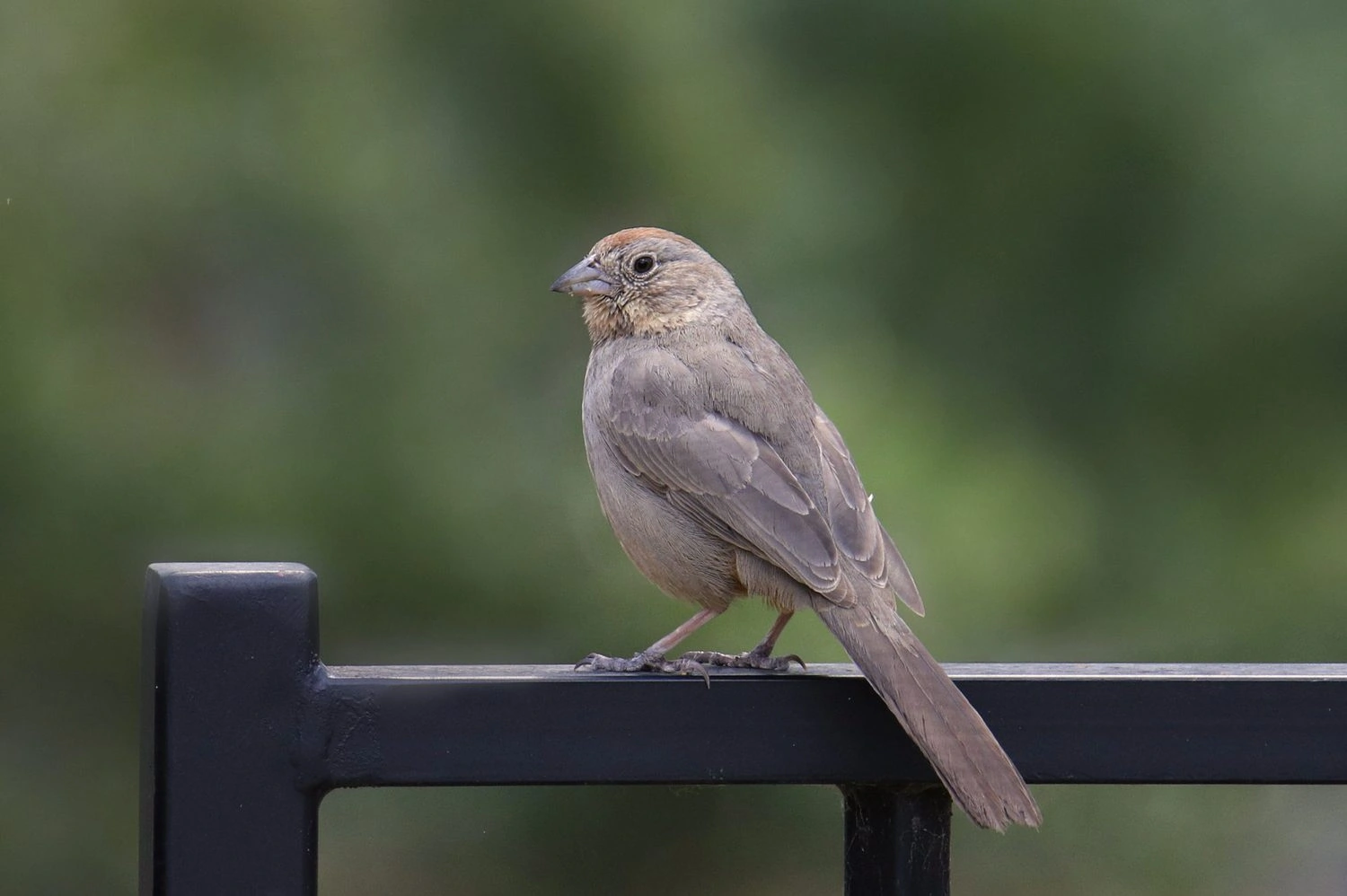
Canyon Towhees are plain grayish-brown sparrows with long tails and plump bodies. Although they look similar to California Towhees, their range does not overlap.
- Melozone fusca
- Length: 8.3-9.8 in (21-25 cm)
- Weight: 1.3-1.9 oz (37-53 g)
- Wingspan: 11.5 in (29.21 cm)
Canyon Towhees are resident all year in southwestern US states and Mexico.
You can find Canyon Towhees on the ground in desert grassland foraging mainly for seeds and berries. However, they will also eat some grasshoppers and other insects.
Canyon Towhee sounds: Their song is fast, stuttering, and two-toned.
Nests of Canyon Towhees are placed near the trunk of trees and large shrubs, so they are well supported and hidden. The nest is made by the female from grass and plant material and is lined with soft grass and animal hair.
Attract Canyon Towhees to your backyard with black oil sunflower seeds, milo, millet, and oats scattered on the ground. However, they are shy birds that can be hard to attract.
Fun fact: Canyon Towhees will nest when the twice-yearly desert rains are due, which provides a sudden abundance of plants and insects.
6. Green-tailed Towhee

Green-tailed Towhees are large sparrows but small for towhees. They are gray with olive-green wings, backs, and tails and have a red crown.
- Pipilo chlorurus
- Length: 7.25 in (18.4 cm)
- Weight: 0.8-1.4 oz (21.5-39.4 g)
Green-tailed Towhees breed in western US states and migrate to southwestern US states and Mexico for winter. They are common in the mountainous west in summer.
You can find Green-tailed Towhees on the ground in dense shrubby vegetation in summer and desert grasslands and thickets, often near streams, in winter. They eat seeds, insects, and berries.
Green-tailed Towhee sounds: Their song is a pleasant series of whistles and slight buzzing.
Nests of Green-tailed Towhees are low in dense vegetation and are built by females from twigs, bark, and other plant material and lined with soft grass and animal hair.
They lay up to five eggs which take just under two weeks to hatch and around a further two weeks for the young to leave the nest.
Fun fact: Female Green-tailed Towhees distract potential predators by quietly leaving the nest and then running around with their tails raised near the nest predator.


